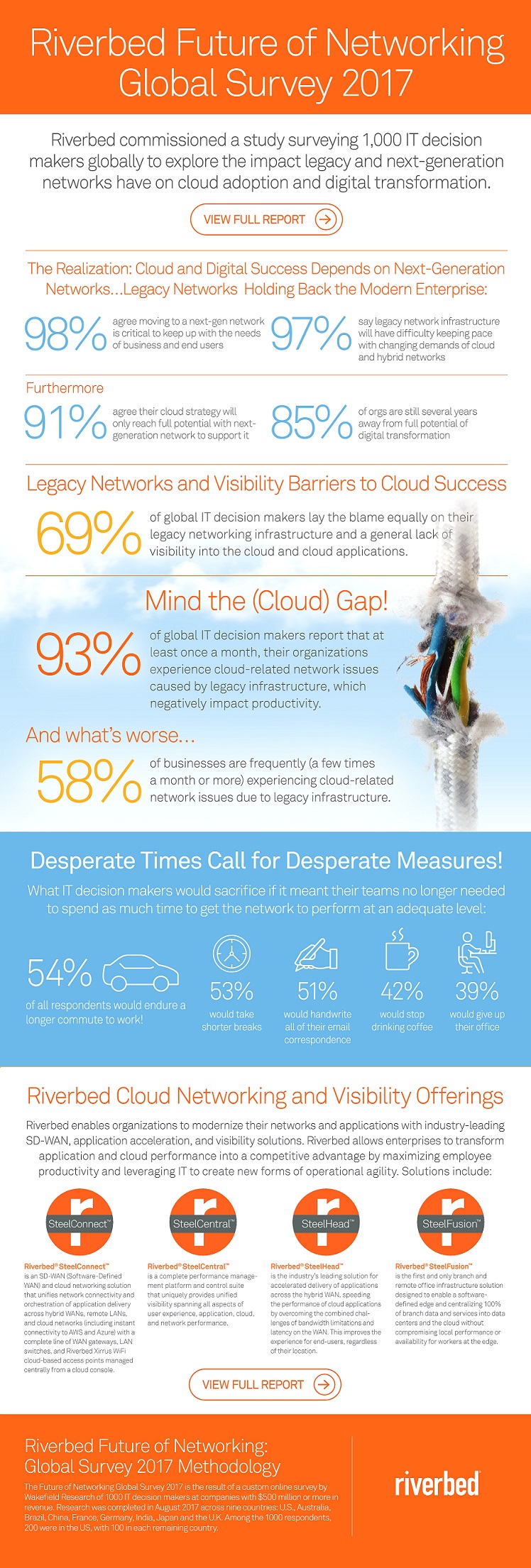
Legacy infrastructures are holding back their cloud and digital strategies, according to the Riverbed Future of Networking Global Survey 2017.
Nearly all survey respondents (97 percent) agree that legacy network infrastructure will have difficulty keeping pace with the changing demands of the cloud and hybrid networks.
Conversely, 91 percent of respondents say their organization's cloud strategy will only reach its full potential with a next-generation network, and 98 percent agree that a next-gen network is critical to keep up with the needs of their business and end users.
The survey also found there is a current gap in the adoption of next-generation technology such as SD-WAN (software-defined wide area networking) that will accelerate the cloud and digital transformation, however a tipping point is near. Of the IT decision makers surveyed, 93 percent plan to migrate to SD-WAN within the next four years, up from just 4 percent today.
"To have a successful cloud strategy, organizations must adopt next-gen software-defined networking immediately to support it."
"This survey and the resulting data reveal the tremendous pressure that IT decision makers are under to execute their cloud strategies, achieve digital transformation and keep pace with the speed of innovation that is the norm in today's hypercompetitive markets," said Jerry M. Kennelly, co-founder and CEO, Riverbed Technology. "It was almost unanimous that "
Currently, performance pains experienced by businesses are glaring, as 58 percent report that they experience cloud-related network issues specifically caused by their legacy infrastructure a few times a month or more; and 93 percent said it impacts their business at least monthly. Unfortunately, 85 percent of these same decision makers say they are still several years away from reaching the full potential of digital transformation, in part due to their legacy infrastructure.
This gap between realization and actual deployment is consistent from companies across verticals such as financial, manufacturing, retail, energy and utilities, communications and media, and IT services, and could threaten their competitive positions in their respective markets.
The inability of these networks to support cloud-centric applications and workloads and just as importantly, provide end-to-end visibility into their performance is viewed as a real challenge to cloud success.
69 percent of respondents stated both legacy networking infrastructure and lack of visibility into the cloud are a barrier to their cloud strategy reaching its full potential.
The survey also found that decision makers do not enjoy dealing with the limitations of their existing legacy networks and would be willing to sacrifice quite a lot if it meant their teams no longer needed to spend as much time to get the network to perform at an adequate level.
In fact, 54 percent would endure a longer commute to work; 53 percent would take shorter lunch breaks; 51 percent would handwrite all of their email correspondence; and 42 percent would actually stop drinking coffee.
Companies are struggling with legacy networks, which are not suited to meet the demands of today's cloud-based applications and their accompanying workloads. Simply put, legacy networks are dysfunctional for the business.
Check back tomorrow for more on next-generation networks.
Read Part 2: Moving to Next-Generation Networks
Methodology: The Riverbed Global Survey 2017: The Future of Networking is the result of a custom online survey by Wakefield Research of 1000 IT decision makers at companies with $500 million or more in revenue. Research was completed in August 2017 across nine countries: US, Australia, Brazil, China, France, Germany, India, Japan and the UK. Among the 1,000 respondents, 200 were in the US, with 100 in each remaining country

